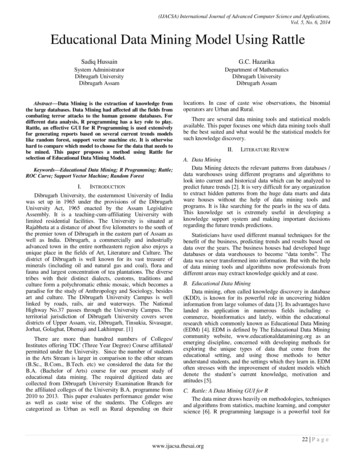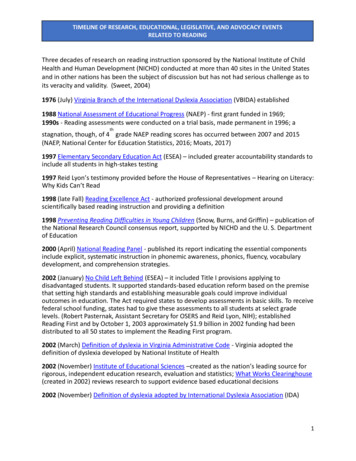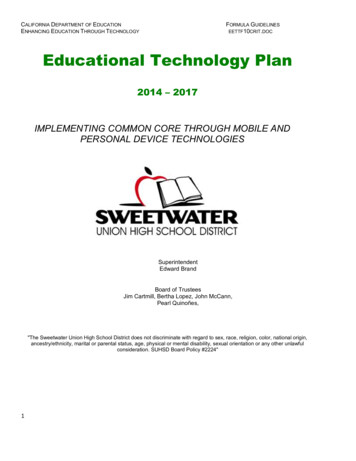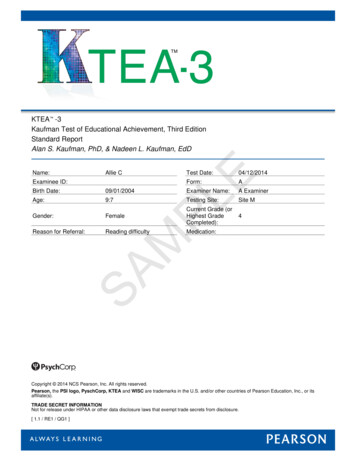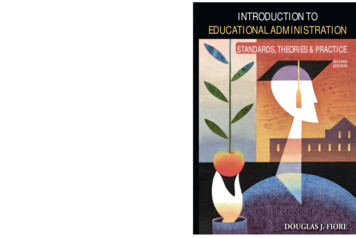
Transcription
International Journal of Humanities and Social ScienceVol. 4, No. 14; December 2014The Effects of Educational Practice with Cartoons on Learning OutcomesCevat EkerAssistant ProfessorDr., Bülent Ecevit UniversityEregli Faculty of EducationEducational Sciences DepartmentZonguldak, TurkeyOğuzhan KaradenizAssistant ProfessorDr., Bülent Ecevit UniversityEregli Faculty of EducationDepartment of Elementary EducationSocial Studies Education DepartmentZonguldak, TurkeyAbstractThis study aims to determine the effects of teaching practices done by using cartoon on students' achievement andknowledge retention. In this study, pretest, posttest control group experimental design was used on a group of 564th grade primary school students in 2013-2014 school year. The study was conducted during six-week long“Good That There” unit in social studies class. Achievement test developed by the researcher was administeredthree times as pre-test, post-test and retention test. The achievement scores gathered from the experiment andcontrol groups were compared with t-test to examine whether there are significant differences between thegroups. Findings indicated that the teaching practices done by using cartoon provided significant differences inincreasing students' academic achievement and the level of knowledge retention in favor of the experimentalgroup. This result illustrated that the teaching done with cartoons affects students' achievements and knowledgeretention positively.Keywords: Cartoon, Social Studies, academic achievement, retention1. IntroductionToday, science and technology has changed rapidly and people have tried to keep pace with these changes. Thestudents who are expected in this swift and mass process, are not the ones who are rote, passive and can respondquickly by using only the shortest way. On the contrary to, the aim of the education is to train the students whoparticipate in the lesson actively and can create alternative ways to solve a problem and can think critically. Thissituation has led to that new education and training approaches gain importance in our education system.It is important that students discover fun and enjoyable aspect of the course and they participate in the lessonactively and the usage of visual aids that can provide more meaningful learning for them by creating discussionenvironment. One of these tools is cartoons, too. Cartoons are the tools that drow students’ attention and ensurethe continuity of this attention, reduce tension and test anxiety and create a more comfortable learningenvironment. (Heitzmann,1998). While Aşçıoğlu (2001) defines “the cartoon” is a humour art which takes itsessence from drawing and can be created by facilitating the technical possibilities of the visual arts, Uslu (2007)defines as humorous drawing of certain depictions.Cartoons are effective tools which are used in order to teach and advise in additon they are funny. Cartoons can beeasily detected by children. In the process of signification of the cartoons, students first concentrate on the line inthe cartoon, then think over every detail, make comments by establishing connection and weave a story in mindsputting out the contrast and associations between objects. Thus, the students think in creative and critical manner(Özalp, 2006).223
Center for Promoting Ideas, USAwww.ijbssnet.comWith this aspect, cartoons are improving the students' critical thinking and problem solving skills and they alsoallow them to express themselves, to think freely and imagine to tell their thoughts and feelings orally and inwriting (Uslu, 2007). Moreover, cartoons enable the studens to realize the events in different aspects while theymake them smile (Black, 2003).In the course, not only making the students laugh but also make them think is one of the main objectives of thecartoon. In cartoons, there is usually a critical perspective. The topic discussed with the creativity is requested tobe examined with a critical perspective by the reader (Topuz, 1986). Course connotations which are taught acartoon which is suitable with its subject are effective and memorable. It is an alternative for education systembased on rote training with bleeding wounds. In the meantime, classes are both fun and develops the intellectualsphere of the mind. It increases the ability to comment on a topic. According to Efe (2004), a teacher who knowscartoon and can use the best save today’s youth from the cartoons which are distasteful, and only include elementsof humor. Instead of this, it provides visibility by offering intellectual lines, motivates the students and creates thethe opportunity of discussion (Özer, 1994).Taking advantages of cartoons in education has not been sufficiently preferred today. However, no tool can maketeaching as interesting as a cartoon. So, cartoon visual aids, it motivates the sutdents and creates the opportunityto discussion. Communicating with cartoon is an easy communication which isn’t complicated. It is noteworthyand surprising, it will be a part which is memorable. The warmth and the charm of the cartoon, and the comfort,which laughing and smiling, have given make the desired message by utilizing relaxation easier to facilitateinsertion into the memory (Özer, 2005).When the students are given lesson by taking advantage of cartoon, those ones will better understand the fact andespecially the knowledge about that subject. (Grünewald, 1979).Cartoons are examined by observing the finedetails and then they contain crucial messages which are generated with the way that events are defined by beingsimplified the details. Therefore, the function of the cartoons which press firmly on the ground of getting thestudents to instruct and to think, increases the effect of cartoon in education (Özer,1998). In this sense, the cartoonhas great importance in terms of education. The importance of the benefitting from cartoons in the process ofeducation and instruction benefit from cartoons, can be summarized as follows: (Holliday ve Grskovic, 2002;Brummett, 2003; Kleeman, 2006; Uslu, 2007).1. Students want entertainment during lesson. Cartoon has the power to achieve it through the language of humor.This language of humor learning leads the student to learn. This enables the students to participate more inclass without getting bored and will provide the lessons with a fun dimension. Because a positive classroomenvironment created in the course by smiling is more beneficial than the lesson taught by being used themethod of narration.2. It is effective in terms of learning the skills and abilities of the students. The teachers attract the student’sattention and help them to learn the subject by asking question about cartoon drawn in the lesson. In addition,the students develop oral and written skills by examining the cartoon which they draw.3. Cartoons are important in terms of that the students establish a relationship between the subjects and theycontribute learners to develop problem solving skills. Students’ perspective for cartoon will be different and itwill bring a wealth of ideas. Thus, it will be easier to capture the details from the information.4. Children's attention span is very limited. The student’s attention is quickly distracted in the class and theyquickly get bored. Teaching the subjects with cartoons will prevent them from getting bored and will providethe focus on lesson for a long time. At the same time, it will be a significant contribution to like the course.5. Cartoon has an important role on motivating the student to the lesson for a long time. When introductionkowledege is being given and their interests decline during lesson, it is effective for focusing on lesson again.This situation will get them to retention.6. Cartoon makes a positive contribution to the development of the students' thinking and comprehension skills.Therefore, they have a role in the formation of a ready audience as the objectives set are effective in teachingthem well.7. Cartoon is effective to communicate with the students. It makes the students it easier to memorize themessages related with the goals. It can be mentioned that humour approach is attractive while communicatingwith the students. Communicating with the cartoon is an easy way that is not complex, there is a side kept inmind.224
International Journal of Humanities and Social ScienceVol. 4, No. 14; December 20148. Education with cartoon has not memorizing. Since cartoons are composed of different, interesting, images andsymbols, they remain in the minds of individuals for along time. As a result, it is easy to remember theknowledge learned.9. Cartoons improve the students’ abilities to comment. Students perspectives for cartoons will be different andinterpretations will be emerge on the same subject. In addition to this case show the richness and diversity ofideas among students, group discussion and finding the most accurate results together brings.10. Drawing cartoon in the classroom will help the students who are interested in cartoon and have the capablefor cartoon to emerge.Even if cartoon is common in our books and schools in recent years, it has been effective on education whichdoesn’t depend on memorization. As a result of this effect, the importance of cartoon in instruction has beenemphasized by being taken place the acquisition expression “Students will perceive the message in the cartoon” inthe field of the visual reading and visual presentation in Turkish lesson for the 4th grade in the primary school(MEB, 2005). Many studies have been done with regard to cartoons in the direction of this importance. However,when the studies are examined abroad (Keogh & Downing, 2001; Stephenson and Warwick, 2002; Alaba, 2007;Chen, Ku & Ho, 2009) and in Turkey (Demir, 2008; Baysarı, 2007; Durmaz, 2007; Üstün, 2007; Atasoy veAkdeniz, 2009; Şaşmaz-Ören, 2009; Yalçın, 2010; Gölgeli ve Saraçoğlu, 2011; Erdoğan ve Cerrah Özgeç, 2012;Tokcan ve Alkan, 2013; Yılmaz, 2013), it has been observed that the concept cartoons are about benefits andlimitations of the classroom practices, the research (Mauro ve Kubovy, 1992; Kılınç, 2006; Durualp, 2006; Özalp2006; Toh, 2007; Köse, 2008; Üner, 2009; Şengül, 2011) that reveals the effects of writing cartoon on the subjectwhich students repeat information, they have learned with free cartoon use and reinforce them to have beenconducted, but the studies correlated to teaching Social Studies lesson in primary school the examined aren’tsuffient. Therefore, the use of the cartoon in the courses as means of alternative and fun have an importance interms of supporting to meaningful learning.In this respect, the purpose of this study is to research how the usage of cartoon and that students draw cartoonaffect on academic achievement of students and the retention levels of their achieved knowledge the process ofteaching the unit which is entitled as “Good That There” in Social Studies in the 4th grade students in Primaryschool. For this purpose, following questions will be sought for answer.Is there a significant difference between the academic achievement pre-test scores of the students in theexperimental group and academic achievement pre-test scores of the students in the control group?Is there a significant difference between the academic achievement pre-test and last-test scores of theexperimental group?Is there a significant difference between the academic achievement pre -test and last test- scores of the controlgroup?Is there a significant difference between the academic achievement last-test scores of the students in theexperimental group and academic achievement last-test scores of the students in the control group?Is there a significant difference between retention scores of the students in the experimental group and retentionscores of the students in the control group?2. MethodIn this section, the research design which will be used in the study, study group, data collection tools, anddocuments related with interpretation of the data and being analyzed have been taken place.2.1. Research DesignThis research has been carried out according to “pre-test-post-test control group model”. There are two groupsformed by randomly assigning in pre-test, post-test control group model. Thus, an experimental and a controlgroup has been formed in this study. In both groups, measurements have been made pre and after the experiment.Pre-tests which take place in the design and are applied to before practices help us to determine the level ofsimilarity of the groups before experiment and last-tests help us interpretation of results (Cohen, Manion veMorrison, 2007).The experimental design used in this study has been shown in Table 1.225
Center for Promoting Ideas, USAwww.ijbssnet.comTable 1: Experimental Design of the studyGroupsPre-testsExperimental groupAcademicachievement test(12.02.2014)Control GroupAcademicachievement testExperimentalProcedureInsruction techniquesdone with the use ofcartoon.(13.02.2014 /20.03.2014)Traditional method(Insruction activitiesbased on high schoolcurriculum, teacher’sbook, approachesLast-tTestsRetention TestAcademicachievement test(21.03.2014)Retention TestAcademicachievement testRetention test(11.4.2014)2.2. Study GroupThe population and sample of the study have consisted a total of 56 students at 4th grade who study in twodifferent classroom of a primary school in the city which is medium sized in the West Black Sea Region inTurkey in 2013-2014 academic year.Datum which is obtained from the scores which are taken from academic achievement pre-test in the units withinthe research, and opinions of Social Studies teachers lesson have been benefitted in the determination of theexperimental and control groups. There have been 28 students in the experimental group and 28 students in thecontrol group. The distribution of students in the sample group has been given in table 2.Distribution of students located in the expermental and control group.
International Journal of Humanities and Social Science Vol. 4, No. 14; December 2014 223 The Effects of Educational Practice with Cartoons on Learning Outcomes Cevat Eker Assistant Professor Dr., Bülent Ecevit University Eregli Faculty of Education Educational Sciences Department Zonguldak, Turkey Oğuzhan Karadeniz Assistant Professor Dr., Bülent Ecevit University Eregli Faculty of .
